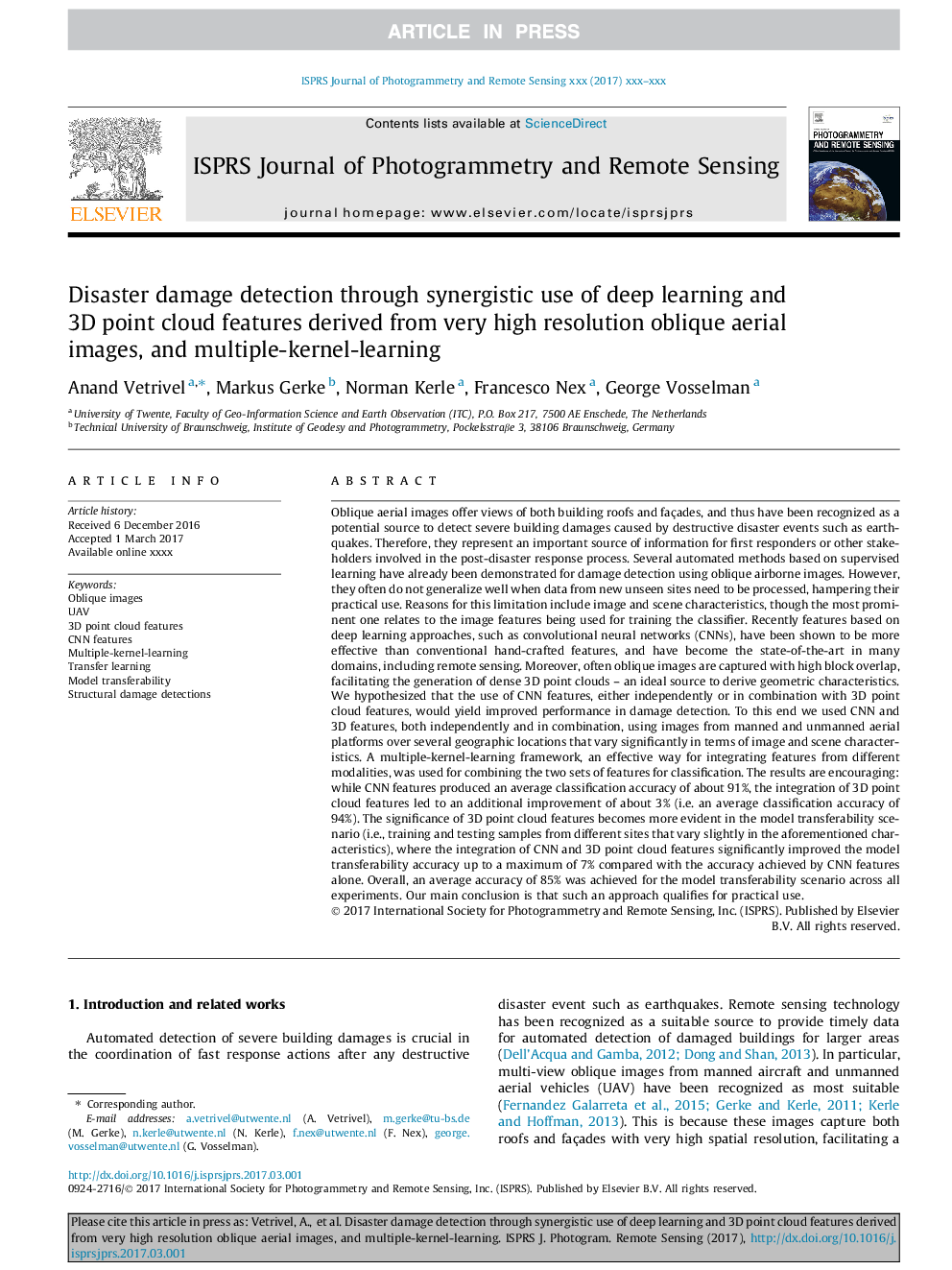| کد مقاله | کد نشریه | سال انتشار | مقاله انگلیسی | نسخه تمام متن |
|---|---|---|---|---|
| 6949149 | 1451234 | 2018 | 15 صفحه PDF | دانلود رایگان |
عنوان انگلیسی مقاله ISI
Disaster damage detection through synergistic use of deep learning and 3D point cloud features derived from very high resolution oblique aerial images, and multiple-kernel-learning
ترجمه فارسی عنوان
تشخیص آسیب های فاجعه از طریق استفاده همزمان از یادگیری عمیق و ویژگی های ابر نقطه ای مشتق شده از تصاویر هوایی با وضوح بسیار بالا و آموزش چند هسته ای
دانلود مقاله + سفارش ترجمه
دانلود مقاله ISI انگلیسی
رایگان برای ایرانیان
کلمات کلیدی
موضوعات مرتبط
مهندسی و علوم پایه
مهندسی کامپیوتر
سیستم های اطلاعاتی
چکیده انگلیسی
Oblique aerial images offer views of both building roofs and façades, and thus have been recognized as a potential source to detect severe building damages caused by destructive disaster events such as earthquakes. Therefore, they represent an important source of information for first responders or other stakeholders involved in the post-disaster response process. Several automated methods based on supervised learning have already been demonstrated for damage detection using oblique airborne images. However, they often do not generalize well when data from new unseen sites need to be processed, hampering their practical use. Reasons for this limitation include image and scene characteristics, though the most prominent one relates to the image features being used for training the classifier. Recently features based on deep learning approaches, such as convolutional neural networks (CNNs), have been shown to be more effective than conventional hand-crafted features, and have become the state-of-the-art in many domains, including remote sensing. Moreover, often oblique images are captured with high block overlap, facilitating the generation of dense 3D point clouds - an ideal source to derive geometric characteristics. We hypothesized that the use of CNN features, either independently or in combination with 3D point cloud features, would yield improved performance in damage detection. To this end we used CNN and 3D features, both independently and in combination, using images from manned and unmanned aerial platforms over several geographic locations that vary significantly in terms of image and scene characteristics. A multiple-kernel-learning framework, an effective way for integrating features from different modalities, was used for combining the two sets of features for classification. The results are encouraging: while CNN features produced an average classification accuracy of about 91%, the integration of 3D point cloud features led to an additional improvement of about 3% (i.e. an average classification accuracy of 94%). The significance of 3D point cloud features becomes more evident in the model transferability scenario (i.e., training and testing samples from different sites that vary slightly in the aforementioned characteristics), where the integration of CNN and 3D point cloud features significantly improved the model transferability accuracy up to a maximum of 7% compared with the accuracy achieved by CNN features alone. Overall, an average accuracy of 85% was achieved for the model transferability scenario across all experiments. Our main conclusion is that such an approach qualifies for practical use.
ناشر
Database: Elsevier - ScienceDirect (ساینس دایرکت)
Journal: ISPRS Journal of Photogrammetry and Remote Sensing - Volume 140, June 2018, Pages 45-59
Journal: ISPRS Journal of Photogrammetry and Remote Sensing - Volume 140, June 2018, Pages 45-59
نویسندگان
Anand Vetrivel, Markus Gerke, Norman Kerle, Francesco Nex, George Vosselman,
